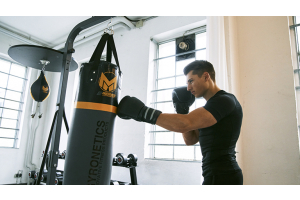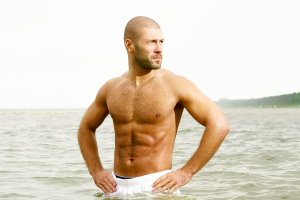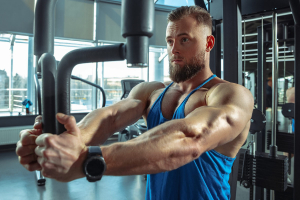Effective Workouts For Killer Forearms
0%


How often do you focus your training on your forearms? Sure, we blast our abs, train out triceps and crush our chest, biceps and back, but all too often we neglect our forearms which comes at a cost. Lets give our forearms the respect they deserve. While having powerful, bulging forearms looks great, it has other benefits too. The stronger your forearm, the better you can perform other exercise into your routine like pullups, rows and deadlifts. The flow on effect from focusing on your forearms will improve every future workout and your overall results
Build strong forearms, build confidence
Thats why it makes sense to build up your forearms. With strong forearms, youll be more confident and effective in the gym . No more worrying about whether that barbells will slip and your grip on dumbbell and other equipment will be stronger too. This guide provides you with practical information on forearm training, including exercises you can easily do at home.
Exactly what is the forearm?
The term forearm is used to distinguish it from the arm, which describe the entire upper limb. The lower part of your arm, therefore, is the forearm which consists of two long bones the radius and the ulna. The ulna is longer and larger than the radius, which runs parallel. Your forearms are made up of a multitude of muscles, nerves and vessels. It plays an important role not only in controlling the hand and fingers, but also the movement functionality of the upper arm.
Your forearm muscles are made up of three distinct groups extensor muscles (dorsally located extensors), flexors (ventral flexors) and the radial forearm muscles.
With the extensor and flexor muscles, a distinction is made between a superficial and deeper muscle layer. This is an overview of the forearm muscles:
Radial forearm muscles:
- upper arm spoke muscle (brachioradialis muscle )
- short radial hand extensor (extensor carpi radialis brevis muscle)
- long radial hand extensor (extensor carpi radialis longus muscle)
Superficial layer of the flexor muscles
- ulnar hand extensor (extensor carpi ulnaris muscle)
- finger extensor (extensor digitorum muscle)
- little finger extensor (extensor digiti minimi muscle
Deeper layer of the extensor muscles:
- long thumb spreader (abductor pollicis longus muscle)
- short thumb extensor (extensor pollicis brevis muscle)
- long thumb extensor (extensor pollicis longus muscle)
- index finger extensor (extensor indicis muscle)
- away dreher (supinator muscle)
Superficial layer of the flexor muscles:
- round inward turner (pronator teres muscle)
- superficial finger flexor (flexor digitorum superficialis muscle)
- long palm muscle (musculus palmaris longus)
- radial hand flexor (flexor carpi radialis muscle)
- elbow-sided hand flexor (flexor carpi ulnaris muscle)
Deep layer of the flexor muscles:
- quadrangular inward rotator (pronator quadratus muscle)
- long thumb flexor (flexor pollicis longus muscle)
- deep finger flexor (flexor digitorum profundus muscle)
While most of the muscles mentioned here are quite obscure, the radial muscle group is one of the more well known. This is the upper arm muscle located on the upper or outer side of the forearm just down from the elbow. A steady routine of hammer curls will get this guy bulging.
5 forearm workouts for fantastic forearms
1 Barbell wrist curls
Kneel down at the side of a flat bench with your forearms placed on the bench. Grab a barbell with an underhand grip and curl it as high as you can. While lowering the barbell, let it roll down to the tip of your fingers. Doing this engages the muscle fibres in your forearms and hands.
Do 3 sets of 15 reps
2 Barbell reverse wrist curls
Sit on a flat bench and lean forward. Holding the barbell with an overhand monkey grip (thumbs over the barbell, palms down, knuckles towards your face). Rest your forearms on the bench or your knees. Using only your wrists, curl the weight upward as you exhale. Slowly lower the weight as low as you are comfortable with,
Do 3 sets of 15 reps
3 Farmers Walk
The farmers walk is essentially walking with a load and is one of the most forgotten yet effective exercise you can do. Its a simple gem you can do with dumbbells, kettlebells, regular barbells, a deadlift bar or specific farmers walk handles.
Simply stand tall holding the weights by your side. Keep your shoulders tight and your back straight. Take short, quick steps as you walk a set distance is only limited by the space. A big gym or outdoors is ideal.
Getting the weight right requires some experimentation at the start but considering youre just holding the weight by your side start off with a 20-30kg dumbbell. If thats a breeze load up a barbell. If this in an exercise you really enjoy, why not invest in special farmers walk barbells or handles you can strap onto the heavier
4 Behind the back wrist curls
Set up a barbell on a rack about knee level and stand facing away from it. Then, bend down and grab the barbell with a shoulder-width grip and stand up straight. Controlling the barbell, let it roll down your fingertips, then curl it back up while flexing your forearms.
Do 3 sets of 12 reps
5 Reverse grip barbell curls
With an overhand grip, grab a barbell and stand feet shoulder width apart. Flex your elbows and rotate the barbell upwards, only using your forearms, until your palms face out and the barbell is in line with your shoulders. Return and slowly repeat.
Do 3 sets of 12 reps
FAQ
Why are strong forearms important?
Strong forearms are important because the strength of your forearms impacts the strength of your grip. Having a firm grip plays a critical role both in everyday life and in many sports including your workout routine. Weak forearms significantly limit performance in many exercises, especially those where you a gripping bellbars, dumbbells and other equipment and machines.
Which exercises are best for forearm training?
You can get those forearms bulging with a variety of exercises including isolation exercises (e.g. forearm curls in the upper or lower grip) and multi-joint exercises (e.g. pullups and deadlifts). Forearm training with the wrist roller is particularly effective and varied.
How intense should forearm training be?
To build muscle mass, you need to high intensity workouts. Training up to muscle failure is, for example, a relevant marker of the right training intensity.











